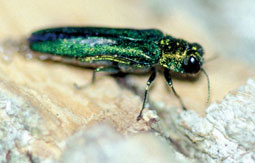Ash
Fraxinus spp
Last month we commented on the wooly adelgid and its attack on the local hemlock. Another pest, the emerald ash borer, has been with us for some time and some unexpected results of this infestation are coming to light. The emerald ash borer has not only devastated ash trees they have created a secondary problem of that involves safety issues. Most trees will stand years after their deaths slowly rotting, providing homes for birds and animals, source of food for woodpeckers and other insect eaters. If they are in someone’s yard they may be taken down by the home owner or a professional sooner rather than late. While there is a minimal risk with dead oaks and maples his is not true of the ash tree.
The ash known to be a very brittle tree. This is compounded by the way the emerald ash borer kills the tree. According to s Beth Corrigan, Community Trees Program specialist with The Morton Arboretum, the ash borer kills the tree by destroying the vascular system that carriers water from the roots. This leaves the tree dehydrated and even more brittle. Even before the tree is totally dead there is a risk of the branches breaking off and falling on homes, vehicles or people. This process can begin within two years of the initial infestation of the tree.
Studies show that even in recently infected trees the moisture content is lower and excessive cracking occurs in the wood. Tests involving the static loading of branches of non-infested trees did not result in the breaking off of branches where they joined the tree trunk. This was not true of trees that were heavily infested with the emerald ash borers. These trees readily broke at the union of trunk and branch resulting in the shedding of heavy, dangerous branches.
Researchers went on to test the strength of the ash trunk from infested and non-infested trees. They did this by drilling the trunk at the base and measuring the resistance. They found a significantly lower resistance in the trunk of ash trees with a heavily infestation of the emerald ash borer than in non-infested trees. There is some indication that the trunk may lose structural integrity with heavy infestations.
What does this mean? It means that if you have an ash tree killed or dying from infestation by the emerald ash borer you have a time bomb on your hands. It is going to start coming apart quickly. This is why many people are having ash trees cut before they are attacked or before symptoms occur. This preemptive removal makes for a safer removal. A structurally sound tree is safer to remove than one that may disintegrate as it is being cut. .
Many professionals who remove trees do so by climbing the tree. They remove the branches starting at the top and often take down the trunk in sections. Done this way there is less risk that the tree will come down on a structure or break branches on nearby trees. This is not a safe procedure with a tree that has branches that may break at the juncture of the branch and the trunk. An infested or dead ash cannot be relied upon to support the weight of a climber. There is the possibility that trunk might snap or branches may break if stressed. Anchoring safety ropes to an unstable tree makes questionable the reliability of the safety ropes. If there are no stable trees nearby to provide an anchor the climber is at risk.
The safest way to remove these unstable trees, according to professionals, may be to cut them at the trunk without attempting to remove branches. This requires finesse, experience and room. While tree cutting experts can generally drop a tree exactly where they want to they are usually dealing with live or stable trees. The precision in placing the tree is dependent on the integrity of what is called the hinge wood or the wood around the cut. Because the ash decays so quickly the wood lacks this stability and it may affect where the tree falls. If there are buildings or other valuable trees or bushes nearby they may be in danger of being destroyed by an erratically falling tree.
For the sake of safety ash trees near buildings should be removed as soon as an infestation is noticed. In attempting to save a tree or hoping that it will recover far worse damage may occur. Remember that no tree is worth the loss of life.
